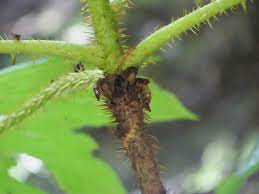Devils Club a plant of intrigue and healing
Devils club has been used by the indigenous culture in the pacific north west for centuries to promote health and healing. A look at the history and beneficial uses of Devil's Club. *Salve instructions included*
3/15/20243 min read


Devil's Club: A Plant of Intrigue and Healing
Devil's club, scientifically known as Oplopanax horridus, is a unique plant native to the temperate rainforests of North America, predominantly found in the Pacific Northwest region. This intriguing plant has a long history of use by indigenous peoples for its medicinal properties and has garnered attention in modern times for its potential health benefits.
Origins and History: The origins of Devil's club trace back centuries, deeply rooted in the cultural practices of indigenous communities inhabiting the regions where it grows. Native American tribes, such as the Tlingit, Haida, and Tsimshian, revered Devil's club for its medicinal properties and spiritual significance. They used various parts of the plant for treating a myriad of ailments and considered it a symbol of protection and healing.
Traditional Uses: Ancient cultures utilized Devil's club for a wide range of purposes, including treating rheumatism, arthritis, digestive issues, respiratory problems, and skin ailments. The plant's bark, roots, and stems were often brewed into teas, applied topically as poultices, or ingested for their purported health benefits. Additionally, Devil's club was believed to possess spiritual qualities, offering protection against negative energies and evil spirits.
Harvesting Practices: Harvesting Devil's club requires careful consideration due to its spiny stems and the plant's ecological importance. Harvesters must exercise caution to avoid damaging the surrounding environment and ensure sustainable practices. It is typically harvested in the late summer or early fall when the plant's medicinal compounds are most potent. Harvesters use gloves and tools to carefully collect the bark and roots, leaving the plant intact to regenerate.
Medicinal Uses and Health Benefits: Devil's club boasts a plethora of medicinal compounds, including saponins, flavonoids, and polyphenols, which contribute to its therapeutic properties. Modern research has begun to validate many of the traditional uses of Devil's club, revealing its potential as an anti-inflammatory, analgesic, and immune-modulating agent. It is believed to support overall health and well-being by promoting immune function, reducing inflammation, and alleviating pain.
Usage in Teas and Salves: One of the most common ways to harness the benefits of Devil's club is by incorporating it into herbal teas and topical salves. Devil's club tea, brewed from the plant's bark or roots, offers a soothing beverage that may help alleviate various ailments, such as sore joints, indigestion, and respiratory issues. Similarly, salves made from Devil's club extracts can be applied externally to relieve muscle aches, skin irritations, and inflammatory conditions.
In conclusion, Devil's club stands as a testament to the profound wisdom of indigenous cultures and the vast potential of natural remedies. While its spiky exterior may appear intimidating, the plant harbors a wealth of healing compounds that continue to captivate the interest of modern herbalists and researchers. Through sustainable harvesting practices and respectful utilization, Devil's club remains a valuable ally in promoting health and vitality, bridging the gap between ancient traditions and contemporary wellness.
How to prepares Salve:
Prepare Devil's Club Infused Oil:
Start by harvesting Devil's club bark or roots sustainably, ensuring you leave enough of the plant intact for regeneration.
Clean the bark or roots thoroughly to remove any dirt or debris, and spikes. (utilizing the green bark)
Chop the bark or roots into small pieces to increase the surface area for extraction.
Place the Devil's club bark or roots in a clean, dry glass jar.
Pour a carrier oil, such as olive oil or coconut oil, over the Devil's club bark or roots until they are fully submerged.
Seal the jar tightly and place it in a warm, sunny spot for 4-6 weeks, shaking it gently every few days to ensure thorough extraction.
After the infusion period, strain the oil through a fine mesh sieve or cheesecloth to remove the plant material, resulting in Devil's club infused oil.
Prepare the Salve:
In a double boiler or a heat-safe bowl placed over a pot of simmering water, combine the Devil's club infused oil and beeswax pellets.
Heat the mixture gently, stirring occasionally, until the beeswax is fully melted and incorporated into the oil.
Optional: Add a few drops of essential oils for fragrance and additional therapeutic benefits, if desired. Stir to combine.
Once the beeswax is melted and the ingredients are well mixed, remove the mixture from heat.
Pour and Store:
Carefully pour the hot salve mixture into clean, dry containers, such as small jars or tins. Note, Dark jars are preferred.
Allow the salve to cool and solidify at room temperature. This may take several hours, depending on the size of the containers and the ambient temperature.
Once cooled and solidified, cap the containers tightly and label them with the date and ingredients.
Store the Devil's club salve in a cool, dry place away from direct sunlight. Properly stored, it should remain potent and effective for several months.
